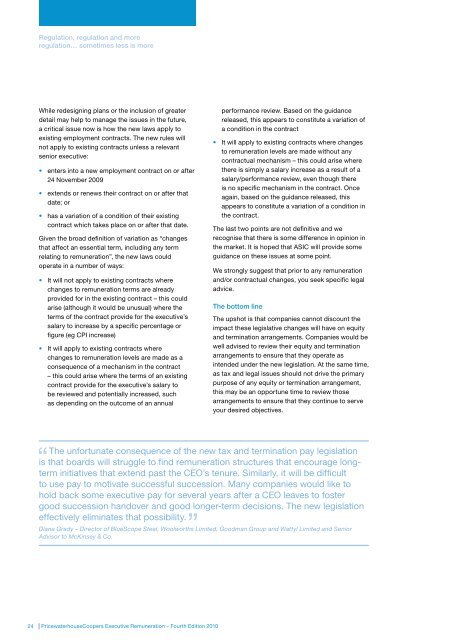How do we rebuild shareholder trust on executive pay
How do we rebuild shareholder trust on executive pay
How do we rebuild shareholder trust on executive pay
You also want an ePaper? Increase the reach of your titles
YUMPU automatically turns print PDFs into web optimized ePapers that Google loves.
Regulati<strong>on</strong>, regulati<strong>on</strong> and more<br />
regulati<strong>on</strong>… sometimes less is more<br />
While redesigning plans or the inclusi<strong>on</strong> of greater<br />
detail may help to manage the issues in the future,<br />
a critical issue now is how the new laws apply to<br />
existing employment c<strong>on</strong>tracts. The new rules will<br />
not apply to existing c<strong>on</strong>tracts unless a relevant<br />
senior <strong>executive</strong>:<br />
• enters into a new employment c<strong>on</strong>tract <strong>on</strong> or after<br />
24 November 2009<br />
• extends or renews their c<strong>on</strong>tract <strong>on</strong> or after that<br />
date; or<br />
• has a variati<strong>on</strong> of a c<strong>on</strong>diti<strong>on</strong> of their existing<br />
c<strong>on</strong>tract which takes place <strong>on</strong> or after that date.<br />
Given the broad definiti<strong>on</strong> of variati<strong>on</strong> as “changes<br />
that affect an essential term, including any term<br />
relating to remunerati<strong>on</strong>”, the new laws could<br />
operate in a number of ways:<br />
• It will not apply to existing c<strong>on</strong>tracts where<br />
changes to remunerati<strong>on</strong> terms are already<br />
provided for in the existing c<strong>on</strong>tract – this could<br />
arise (although it would be unusual) where the<br />
terms of the c<strong>on</strong>tract provide for the <strong>executive</strong>’s<br />
salary to increase by a specific percentage or<br />
figure (eg CPI increase)<br />
• It will apply to existing c<strong>on</strong>tracts where<br />
changes to remunerati<strong>on</strong> levels are made as a<br />
c<strong>on</strong>sequence of a mechanism in the c<strong>on</strong>tract<br />
– this could arise where the terms of an existing<br />
c<strong>on</strong>tract provide for the <strong>executive</strong>’s salary to<br />
be revie<str<strong>on</strong>g>we</str<strong>on</strong>g>d and potentially increased, such<br />
as depending <strong>on</strong> the outcome of an annual<br />
performance review. Based <strong>on</strong> the guidance<br />
released, this appears to c<strong>on</strong>stitute a variati<strong>on</strong> of<br />
a c<strong>on</strong>diti<strong>on</strong> in the c<strong>on</strong>tract<br />
• It will apply to existing c<strong>on</strong>tracts where changes<br />
to remunerati<strong>on</strong> levels are made without any<br />
c<strong>on</strong>tractual mechanism – this could arise where<br />
there is simply a salary increase as a result of a<br />
salary/performance review, even though there<br />
is no specific mechanism in the c<strong>on</strong>tract. Once<br />
again, based <strong>on</strong> the guidance released, this<br />
appears to c<strong>on</strong>stitute a variati<strong>on</strong> of a c<strong>on</strong>diti<strong>on</strong> in<br />
the c<strong>on</strong>tract.<br />
The last two points are not definitive and <str<strong>on</strong>g>we</str<strong>on</strong>g><br />
recognise that there is some difference in opini<strong>on</strong> in<br />
the market. It is hoped that ASIC will provide some<br />
guidance <strong>on</strong> these issues at some point.<br />
We str<strong>on</strong>gly suggest that prior to any remunerati<strong>on</strong><br />
and/or c<strong>on</strong>tractual changes, you seek specific legal<br />
advice.<br />
The bottom line<br />
The upshot is that companies cannot discount the<br />
impact these legislative changes will have <strong>on</strong> equity<br />
and terminati<strong>on</strong> arrangements. Companies would be<br />
<str<strong>on</strong>g>we</str<strong>on</strong>g>ll advised to review their equity and terminati<strong>on</strong><br />
arrangements to ensure that they operate as<br />
intended under the new legislati<strong>on</strong>. At the same time,<br />
as tax and legal issues should not drive the primary<br />
purpose of any equity or terminati<strong>on</strong> arrangement,<br />
this may be an opportune time to review those<br />
arrangements to ensure that they c<strong>on</strong>tinue to serve<br />
your desired objectives.<br />
The unfortunate c<strong>on</strong>sequence of the new tax and terminati<strong>on</strong> <strong>pay</strong> legislati<strong>on</strong><br />
is that boards will struggle to find remunerati<strong>on</strong> structures that encourage l<strong>on</strong>gterm<br />
initiatives that extend past the CEO’s tenure. Similarly, it will be difficult<br />
to use <strong>pay</strong> to motivate successful successi<strong>on</strong>. Many companies would like to<br />
hold back some <strong>executive</strong> <strong>pay</strong> for several years after a CEO leaves to foster<br />
good successi<strong>on</strong> han<str<strong>on</strong>g>do</str<strong>on</strong>g>ver and good l<strong>on</strong>ger-term decisi<strong>on</strong>s. The new legislati<strong>on</strong><br />
effectively eliminates that possibility.<br />
Diane Grady – Director of BlueScope Steel, Woolworths Limited, Goodman Group and Wattyl Limited and Senior<br />
Advisor to McKinsey & Co.<br />
24<br />
| PricewaterhouseCoopers Executive Remunerati<strong>on</strong> – Fourth Editi<strong>on</strong> 2010

















